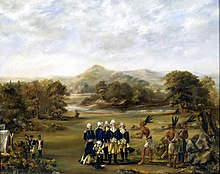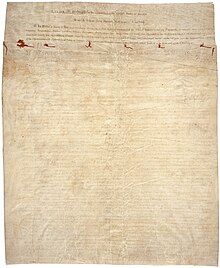Treaty of Greenville: Difference between revisions
No edit summary |
No edit summary |
||
| Line 32: | Line 32: | ||
The treaty also established the "annuity" system - yearly grants of federal money and calico cloth to Indian tribes that insitutionalized continuing governments influence in tribal affairs and gave outsiders considerable control over Indian life.(Foner's Give me Liberty) |
The treaty also established the "annuity" system - yearly grants of federal money and calico cloth to Indian tribes that insitutionalized continuing governments influence in tribal affairs and gave outsiders considerable control over Indian life.(Foner's Give me Liberty) |
||
On July 22, 1814 General William Harrison and Governor Cass held a second treaty with the Wyandot, Delaware, Shawnee, Seneca, Miami and Potawatomi at the same place where the original treaty had been. |
On July 22, 1814 General William Harrison and Governor Cass held a second treaty with the Wyandot, Delaware, Shawnee, Seneca, Miami and Potawatomi at the same place where the original treaty had been.<ref>[http://www.ohiohistorycentral.org/entry.php?rec=453</ref>] |
||
<br /> |
<br /> |
||
==Notes== |
==Notes== |
||
Revision as of 23:13, 3 January 2010
The Treaty of Greenville was signed at Fort Greenville (now Greenville, Ohio), on August 2, 1795, between a coalition of Native Americans known as the Western Confederacy and the United States following the Native American loss at the Battle of Fallen Timbers. It put an end to the Northwest Indian War. The United States was represented by General "Mad Anthony" Wayne, who led the victory at Fallen Timbers. In exchange for goods to the value of $20,000 (such as blankets, utensils, and domestic animals), the Native Americans turned over to the United States large parts of modern-day Ohio, the future site of downtown Chicago,[nb 1][2] and the Fort Detroit area.


Native American leaders who signed the treaty included members of these tribes:
- Wyandot
- Delaware (Lenape; several bands)
- Shawnee
- Ottawa (several bands)
- Chippewa
- Potawatomi (several bands)
- Miami (several bands)
- Wea
- Kickapoo
- Kaskaskia

The treaty established what became known as the "Greenville Treaty Line," which was for several years a boundary between Native American territory and lands open to white settlers, although the treaty line was frequently disregarded by settlers as they continued to encroach on native lands guaranteed by the treaty. The treaty line began at the mouth of the Cuyahoga River in present-day Cleveland and ran south along the river to the portage between the Cuyahoga and Tuscarawas River in what is now known as the Portage Lakes area between Akron and Canton. The line continued down the Tuscarawas to Fort Laurens near present-day Bolivar. From there, the line ran west-southwest to near present-day Fort Loramie on a branch of the Great Miami River. From there, the line ran west-northwest to Fort Recovery, on the Wabash River near the present-day boundary between Ohio and Indiana. From Fort Recovery, the line ran south-southwest to the Ohio River at a point opposite the mouth of the Kentucky River in present-day Carrollton, Kentucky.
William Clark of the Lewis and Clark Expedition was present at Greenville. Years later he met again one of the Delware chiefs he had met at the conference, noting in his journal for December 23, 1803: "a raney day… several Deleaway pass, a chief whome I saw at Greenville Treaty, I gave him a bottle of whiskey."[5]

Reactions
Many prominent figures, however, rejected the idea that Indians were innately inferior to white Americans. Thomas Jefferson believed that Indians merely lived at a less advanced stage of civilization. Indians could becom full-fledged members of the repulic by abandoning communal landholding and hunting in favor of small-scale farming. Once they "possessed property." Jefferson told one Indian group, they could "join us in our government" and indeed, "mix your blood with ours." (Foner's Give me Liberty)
Aftermath
The treaty also established the "annuity" system - yearly grants of federal money and calico cloth to Indian tribes that insitutionalized continuing governments influence in tribal affairs and gave outsiders considerable control over Indian life.(Foner's Give me Liberty)
On July 22, 1814 General William Harrison and Governor Cass held a second treaty with the Wyandot, Delaware, Shawnee, Seneca, Miami and Potawatomi at the same place where the original treaty had been.[6]]
Notes
References
- ^ Charles J. Kappler (1904). "TREATY WITH THE WYANDOT, ETC., 1795". U.S. Government treaties with Native Americans. Oklahoma State University Library. Retrieved 1 August 2009.
- ^ "Fort Dearborn" in online Encyclopedia of Chicago accessed 2009-08-01
- ^ Furlong, William Rea; McCandless, Byron (1981). So Proudly We Hail : The History of the United States Flag. Washington, D.C.: Smithsonian Institution Press. p. 160. ISBN 0-87474-448-2.
- ^ [http://www.in.gov/history/2897.htm Anthony Wayne Flag (Greenville Treaty Flag)
- ^ G. Moulton, ed. The Journals of the Lewis and Clark Expedition. Vol. 2, p. 140.
- ^ [http://www.ohiohistorycentral.org/entry.php?rec=453
